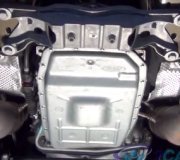Not only possibly, but likely. That is just as serious as being low on fluid. With an extra quart or two, the fluid will reach up to the rotating drums. Those will whip it around and whip air into it. Just as with engine oil, air compresses, so it reduces the oil's ability to isolate moving parts from each other. In other words, it won't lubricate. Also, hydraulic oil pressure pushes on the clutch plates to engage them. When the fluid is aerated, it takes a lot more fluid volume to apply a clutch pack. With aerated fluid that can compress, it takes longer to build pressure, and when it takes longer to build pressure, it takes longer to flow the needed volume. It takes more volume and it takes longer to get it. Both of those mean excessive slippage will take place. Just like riding a manual transmission clutch, that wears the clutch plates down very quickly. Worn clutch plates means even more fluid volume has to fill in behind them, so the problem gets worse very quickly.
What you have going for you is your transmission is computer-controlled and the computer watches the input and output speed sensors to detect that slippage. When it occurs, it defaults to "limp mode" and stays in second gear. If that hasn't been happening, you can suspect no damage has occurred to the clutch plates. In fact, the computer won't allow it to occur. It will go to limp mode at the first sign of slippage before that wear has time to occur.
Be sure you're checking the fluid level as specified on the dip stick. Usually that requires the engine to be warmed up and running, and the transmission is in park or neutral. If the car is due for a regular transmission service, drop the pan and replace the filter, then refill it to the proper level. As I recall, that will take around four quarts, possibly five. The rest of the air will work itself out while the engine is off. When it's running, none of the drums are rotating in the transmission until the car is moving. Even at low speeds, they aren't spinning fast enough to whip that air into the fluid.
If it's not time for scheduled service, use a suction pump with a two-foot long hose to suck out the excess fluid through the dip stick tube.
Friday, November 29th, 2013 AT 6:24 PM



